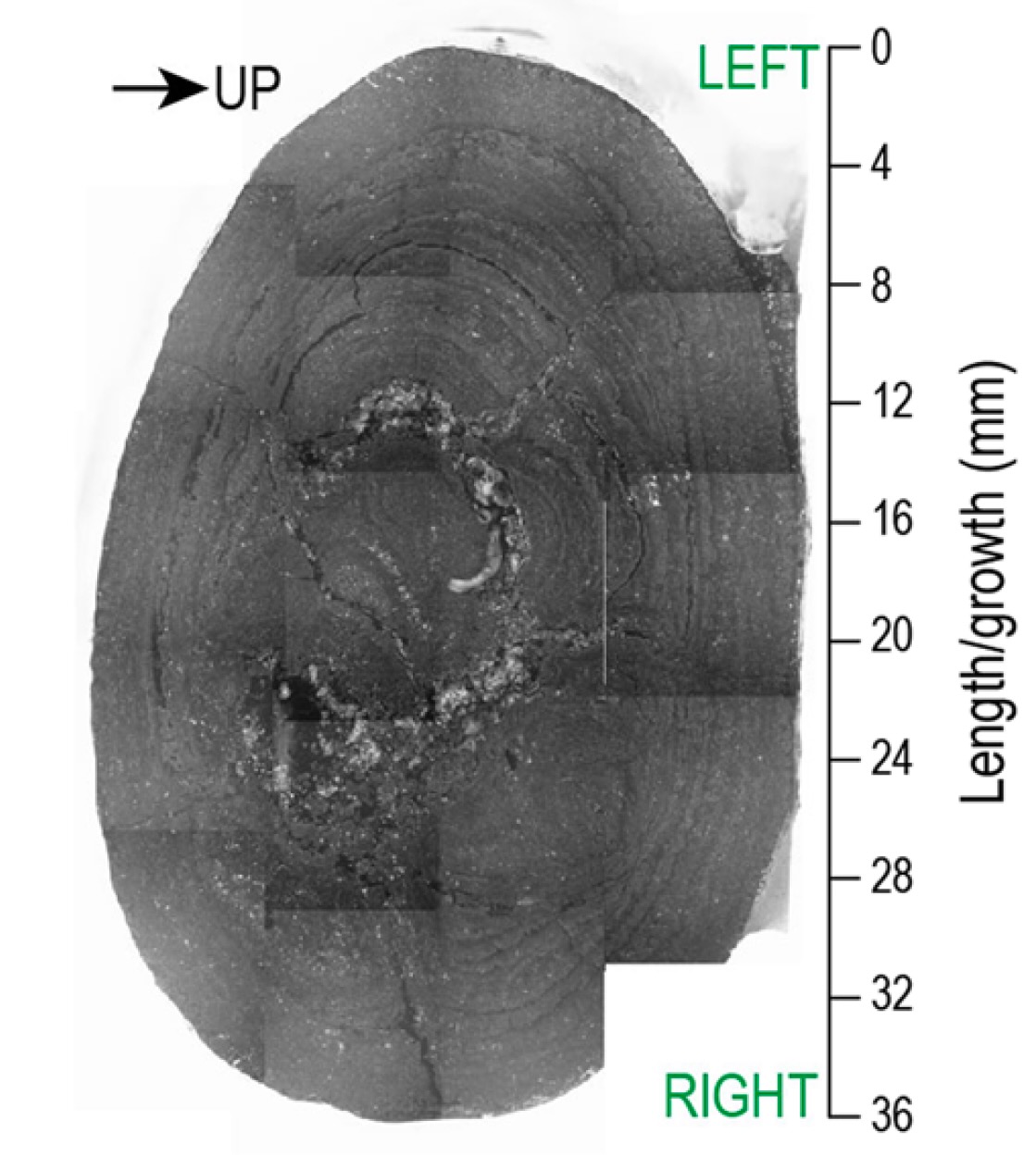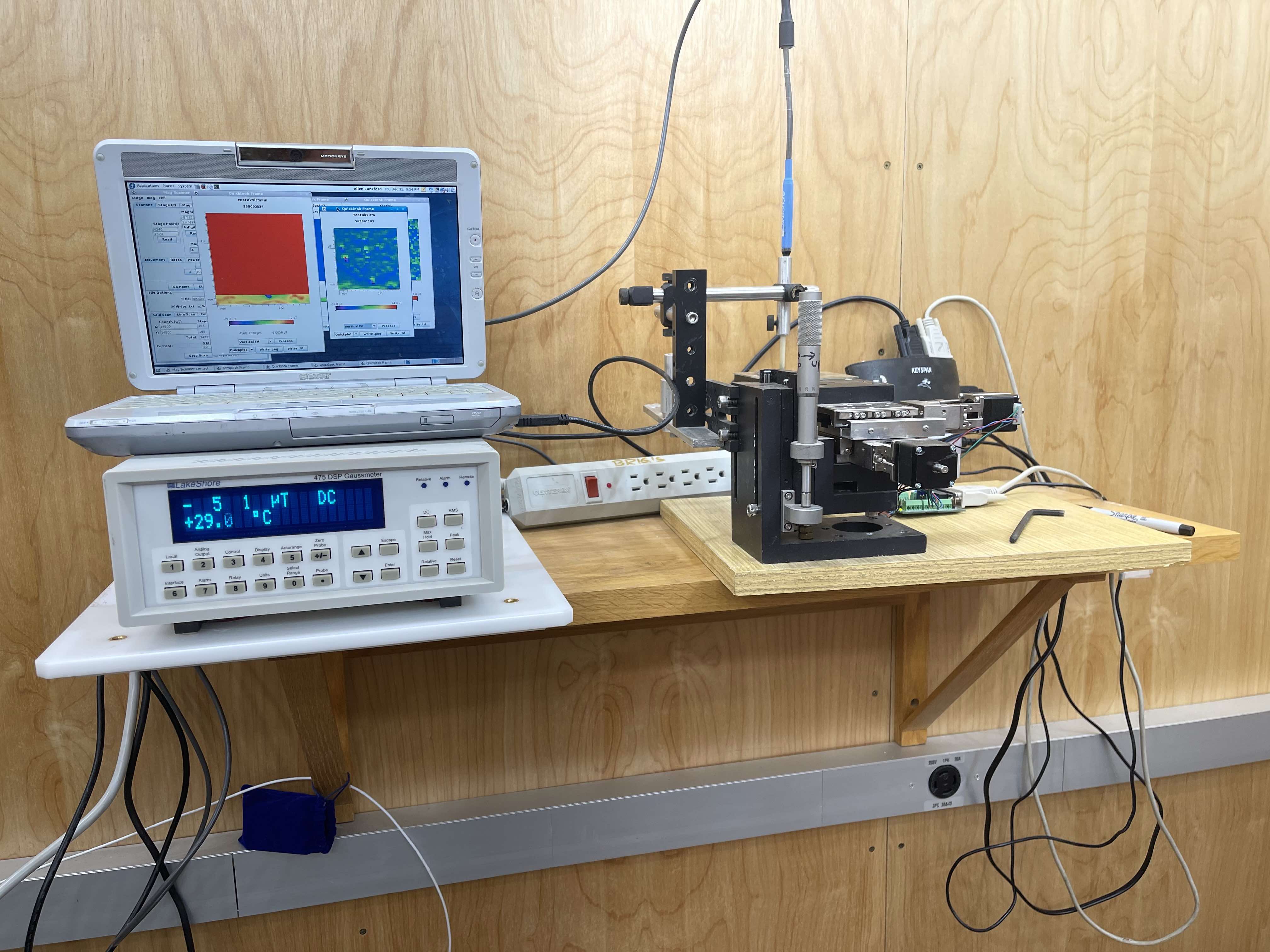Paleomagnetism aids research on the Northern Hemisphere Glaciation
Rod Boyce
907-474-7185
April 14, 2023
Ten years ago, a Chinese research vessel floating 2,700 miles off the coast of California reached 16,500 feet below the surface to retrieve a small piece of Pacific Ocean floor.
Researchers say a one-fifth-inch slice of that nodule, which measured 1 by 1.4 inches before it was sliced open for analysis, contains information about the relationship between deep Antarctic waters and the behavior of the Northern Hemisphere Glaciation. That glacial period began approximately 2.7 million years ago.

This scanned image of a slice of the Pacific Ocean nodule reveals the nodule’s growth rings.
The research was published Feb. 24 in the journal Science Advances. Associate research professor Gunther Kletetschka at the University of Alaska Fairbanks Geophysical Institute is among the 11 contributors. The research was led by Liang Yi of Tongji University, Shanghai, China.
Information gleaned from the nodule couldn’t be properly placed on Earth’s geologic timeline without knowing the nodule’s precise age.
That’s where paleomagnetism expert Kletetschka came in. Paleomagnetism is the study of magnetism imprinted on rocks by Earth’s magnetic field at the time of the rocks’ formation.
Kletetschka used a high-resolution magnetic scanner in the UAF Reichardt Building to analyze the slice of the marine ferromanganese nodule.
“Through magnetic scanning, we found that the age of this nodule is about 4.7 million years,” he said.
To get that precision, Kletetschka used a method he and others developed and reported in 2020. The process involves magnetic and chemical scanning and analysis of beryllium isotopes and cobalt atom concentration.
The research also revealed the age of the individual layers in the sample’s interior. The dating was possible because the scanning revealed the changes in Earth’s north-south magnetic polarity imprinted on the nodule over millions of years.
“With the outside of the nodule we see that the magnetic field is in the direction of today's magnetic field,” Kletetschka said. “But when we went about half a centimeter into the nodule, we saw that the polarity had reversed.”

Gunther Kletetschka
A series of rings within the sample disclosed a history of polarity change. Scientists then matched that against the known history of Earth’s polarity changes. The planet’s polarity has been reversing every 200,000 to 300,000 years for about the last 20 million years, though it has been more than twice that since the most recent change.
The sample nodule likely grew from a single grain of sand. Kletetschka explained that the ocean bottom contains a lot of iron and manganese. The depths also contain higher levels of free dissolved oxygen, which leads to oxidation of the iron and manganese.
“This allows some atoms of the iron and manganese to precipitate onto a tiny grain of sand,” he said. “And it continues over the ages, making a nodule that gets bigger and bigger.”
For the researchers, marine ferromanganese nodules and other crustal formations of metal oxides become recorders of bottom-water oxygen levels.

Associate research professor Gunther Kletetschka used this high-resolution magnetic scanner at the University of Alaska Fairbanks to analyze a slice of the Pacific Ocean nodule.
Knowing the oxygen level reveals the strength and weakness of what is known as ocean ventilation. The deep Antarctic water, known as Antarctic bottom water, is a key factor in global ocean ventilation.
The ventilation system starts when cold, salty water in the Arctic and North Atlantic drops deep under the surface. The water then moves south to Antarctica and eventually into the Pacific and Indian oceans before returning to the Atlantic.
The paper’s authors say the record within the Pacific Ocean nodule reflects conditions where Antarctic bottom water originates at the submerged shelf of the Antarctic continent.
With Kletetschka’s work, researchers were able to place on Earth’s geologic timeline the oxygen-level indicators revealed by chemical scanning of the nodule’s rings.
The result is a record of deep-sea ventilation going back 4.7 million years, the age of the nodule.
The researchers say the data provides “compelling evidence” of a link between episodes of low bottom-water oxygen, changes in Antarctic ice sheet volume and decreases in Northern Hemisphere Glaciation ice volume.
ADDITIONAL CONTACT: Gunther Kletetschka, 907-474-7090, gkletetschka@alaska.edu
162-23


